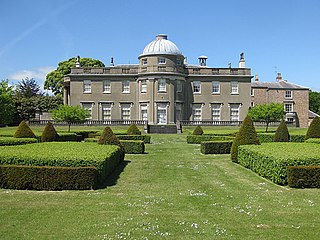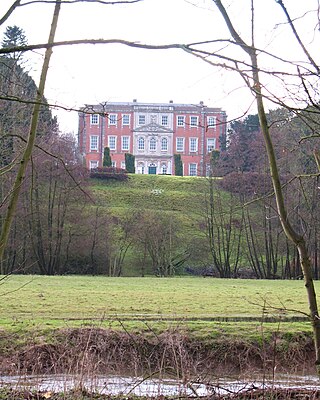
Shugborough Hall is a stately home near Great Haywood, Staffordshire, England.
Baron Ravensworth, of Ravensworth Castle in the County Palatine of Durham and of Eslington Park in the County of Northumberland, is a title in the Peerage of the United Kingdom.

Scampston Hall is a Grade II* listed country house in North Yorkshire, England, with a serpentine park designed by Charles Bridgeman and Capability Brown. It is located on the north side of the A64 Leeds/Scarborough road, 4 miles (6 km) east of Malton, in Scampston village. The name of the village was referred to in various ways in ancient documents as: Scamestun, Skameston, Skameston, and Skampston, and was probably derived from a personal name.

Sewerby Hall is a Grade I listed Georgian country house set in 50 acres (20 ha) of landscaped gardens in the village of Sewerby, 2 miles (3.2 km) from the seaside town of Bridlington in the East Riding of Yorkshire, England.

Barham is a village and civil parish in the City of Canterbury district of Kent, England. Barham village is approximately 6 miles (10 km) south-east from Canterbury and 8 miles (13 km) north from Folkestone.

Gunnersbury Park is a park between Acton, Brentford, Chiswick and Ealing, West London, England. Purchased for the nation from the Rothschild family, it was opened to the public by Neville Chamberlain, then Minister of Health, on 21 May 1926. The park is currently jointly managed by Hounslow and Ealing borough councils. A major restoration project funded by the Heritage Lottery Fund was completed in 2018. The park and garden is Grade II listed.

Cassiobury House was a country house in Cassiobury Park, Watford, England. It was the ancestral seat of the Earls of Essex. Originally a Tudor building, dating from 1546 for Sir Richard Morrison, it was substantially remodelled in the 17th and 19th centuries and ultimately demolished in 1927. The surrounding Cassiobury Park was turned into the main public open space for Watford.

Hylands House is a Grade II* neo-classical villa situated within Hylands Park a 232-hectare park southwest of Chelmsford in Essex in South East England. It is owned and operated by Chelmsford City Council.

Sudbury is a suburb in the London Borough of Brent, located in northwest London, United Kingdom. The suburb forms the western part of Wembley and is centred around 0.6 miles (1 km) west of Wembley Central railway station.

Rolvenden is a village and civil parish in the Ashford District of Kent, England. The village is centred on the A28 Ashford to Hastings road, 5 miles (8.0 km) south-west of Tenterden.

Aldby Park is a country estate in the village of Buttercrambe near the village of Stamford Bridge in the East Riding of Yorkshire, England.

(New) Hawarden Castle is a house in Hawarden, Flintshire, Wales. It was the estate of the former British prime minister William Gladstone, having previously belonged to the family of his wife, Catherine Glynne. Built in the mid-18th century, it was later enlarged and externally remodelled in the Gothic taste.

Great Maytham Hall, near Rolvenden, Kent, England, is a Grade II* listed country house. The gardens are famous for providing the inspiration for The Secret Garden by Frances Hodgson Burnett.

Sudbourne is a village and civil parish in Suffolk, England, located approximately 2 miles (3 km) north of Orford.
Marbury Hall was a country house in Marbury, near Northwich, Cheshire, England. Several houses existed on the site from the 13th century, which formed the seat successively of the Marbury, Barry and Smith-Barry families, until 1932. An extensive collection of artwork and sculpture was housed at the hall from 1801 until the 1930s. The final house was extensively remodelled by Anthony Salvin in the 1850s.

Basildon Park is a country house situated 2 miles south of Goring-on-Thames and Streatley in Berkshire, between the villages of Upper Basildon and Lower Basildon. It is owned by the National Trust and is a Grade I listed building. The house was built between 1776 and 1783 for Sir Francis Sykes and designed by John Carr in the Palladian style at a time when Palladianism was giving way to the newly fashionable neoclassicism. Thus, the interiors are in a neoclassical "Adamesque" style.
Raikes Currie was Member of Parliament (MP) for Northampton from 1837 to 1857. He was a partner of the bank Curries & Co., which became part of Glyn, Mills & Co. in 1864, along with his father, Isaac Currie, in Cornhill, City of London, and had several interests in the newly developing colony of South Australia. He restored Minley Manor and made substantial improvements to the estate, work which was continued by his son and grandson.
Sir George Barham was an English businessman and founder of the Express County Milk Company, later to become Express Dairies. He is sometimes described as the father of the British dairying industry.

Boynton Hall is a country house in the village of Boynton near Bridlington, East Riding of Yorkshire, England. It is a Grade I listed building.


















